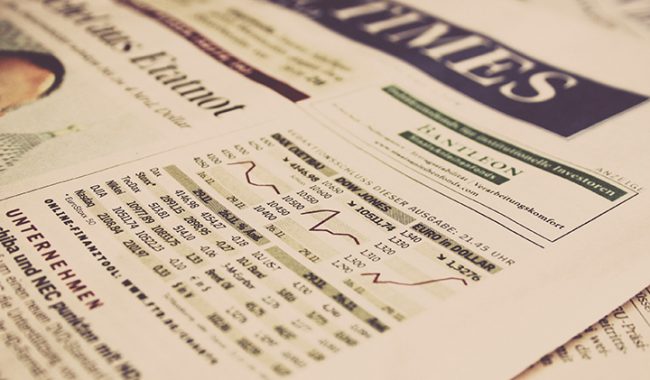An article by Sergio Focardi, professor and researcher in finance at ESILV and EMLV and member of the De Vinci Research Center’s Finance group, first published in The Conversation. 
This article is based on the monograph “Equity Valuation: Science, Art or Craft?” of the CFA Institute Research Foundation, coauthored by Frank Fabozzi, Sergio Focardi and Caroline Jonas.
With the US Federal Reserve announcing that it will be unwinding quantitative easing (QE) and the European Central Bank (ECB) halving its monthly purchase of assets, the current record price level of stocks is a growing concern. But how can we determine if a stock or stock markets in general are fairly priced or overpriced?
The price at which a stock is traded in the market reflects the ability of the firm to generate future cash flows and the risks associated with generating these flows. However widely used valuation techniques have limits, the most important of these being the inability to forecast cash flows and to determine the appropriate discount rate. The widely used market-multiple valuation techniques, including the price-to-earnings (P/E) ratio, capture only relative value, that is, the value of a firm’s stock relative to the value of stocks from comparable firms, assuming that comparable firms can be identified. They cannot inform if an entire market or segments of the market are overvalued, that is to say, they cannot determine the absolute value of a stock or of the stock market in general.
While many investors are focused on individual companies, the absolute valuation of markets in aggregate is important too. Writing in his blog back in 1996, four years before the dot-com bubble burst, University of California-Berkeley economist Bradford DeLong remarked:
“The stakes for investors are truly enormous. If the $7 trillion U.S. stock market is overvalued by a third, some $2 trillion plus of the wealth [now held in US stocks] will vanish over the next decade as stock prices return to fundamentals.”
One standard measure of a firm’s fundamentals is the ratio of the price at which the stock is trading to the company’s earnings, the P/E ratio. Historically speaking, a typical stock in a typical year has been priced at about 15 times its earnings, that is to say, its price-to-earnings ratio has been about 15. Today the price-to-earnings ratio of S&P 500 firms is 25, 65% to 70% higher than during the period 1935-1995. Nevertheless, part of the high valuations might be explained by improved profit margins or other factors. For example, compared to the pre-1997 period, the margins of S&P 500 firms have risen by about 30%.
The law of supply and demand in the pricing of stocks
Ultimately, the price of an asset is established by supply and demand. Determining if stocks are fairly priced implies determining if there is an excess or dearth of demand for investments. It can be argued that excess demand has been created by:
- Central banks’ policies including quantitative easing and low-to-negative interest rates following the 2007-2008 financial crisis.
- A dearth of shares now in public markets.
Quantitative easing by the US Federal Reserve added $4.5 trillion in liquidity to the market; the European Central Bank added another €1.7 trillion, to cite the actions of only two central banks.
In the US in particular, the dearth of shares in public markets has been attributed to a combination of delistings coupled with a low rate of new listings and share buybacks. A 2015 study from the National Bureau of Economic Research (NBER) identified a US “listing gap”: The number of listed firms declined from a high of 8,025 in 1996 to 4,101 in 2012 (the figure was around 4,300 at the end of 2016). As for share buybacks, by some estimates US listed firms spent $6.1 trillion buying back their own shares during the 11-year period 2005-2016. Indeed some equity analysts consider corporate buybacks to be the sole factor holding up demand for US equities in today’s market.
Share buybacks are not limited to US firms: The phenomenon has been growing in Europe and Japan but compared to the US, buybacks there still represent only a small proportion of market capitalization.
Understanding if markets are overpriced
One method frequently used for understanding if markets are overpriced is referred to as the Buffett rule which states that markets are fairly or over-/under-valued in function of the ratio between total market capitalization and GDP (i.e., TMC-to-GDP ratio). The underlying intuition is that, overall, the return on financial assets such as stocks cannot stay disconnected too long from economic growth.
Following the dot-com bubble of the late 1990s, Warren Buffett embraced the ratio of the Wilshire 5000 full-cap index to the US GDP as likely the best single measure of where valuations stand at any given moment. According to data from the World Bank, during the period 1975-1985 the average TMC-to-GDP for the US was under 50; at the end of the dot-com bubble in early 2000 it reached a peak of 153%; it was 147% for the year 2016. By comparison, the 2016 TMC-to-GDP ratio was 51% for Germany, 87% for France, 100% for Japan and 106% for OECD members in aggregate (data from the World Bank).
The TMC-to-GDP ratio has been criticized on several counts, among them the fact that it does not take into account structural changes in profit margins (as mentioned above) caused by, for example, stagnant wages, changing tax rates, lower interest rates or technological innovation. Nor does the ratio take into account institutional differences between countries. For example, a great deal of the equity in German companies is family-owned and thus not listed in public exchanges.
But the critical fact is that economies are complex systems with complex output. It is basically impossible to average real (as opposed to nominal) growth over a whole market and a whole economy. In addition, the growth rate of an economy is a simplification that does not take into account how that growth is achieved and the inequalities inside an economy. While relative valuations are a robust tool for portfolio construction, absolute valuations – linked to complex macroeconomic considerations – cannot be ignored.





















